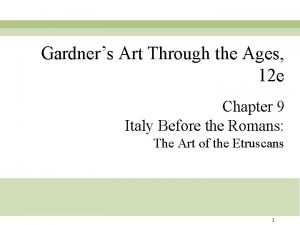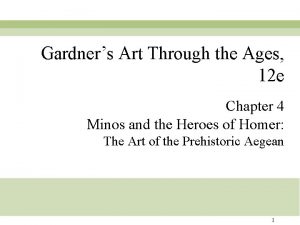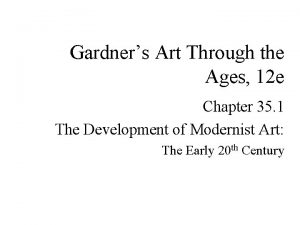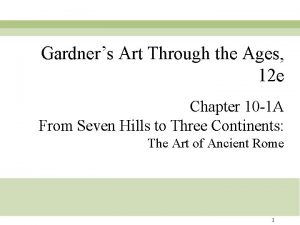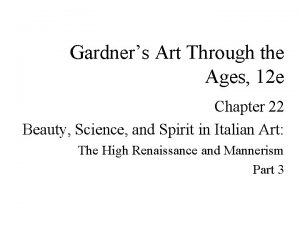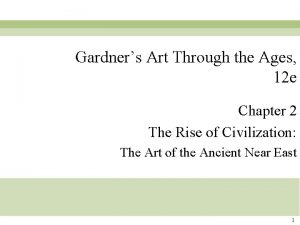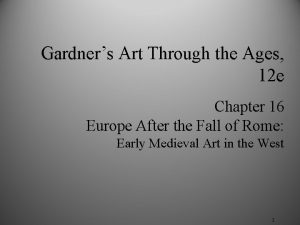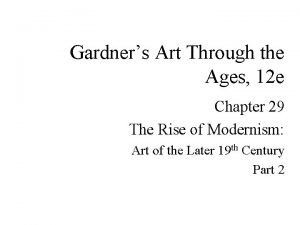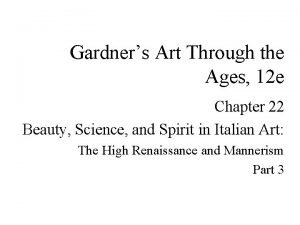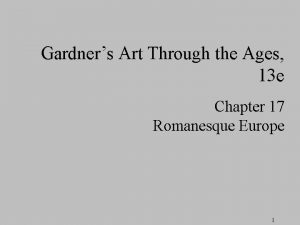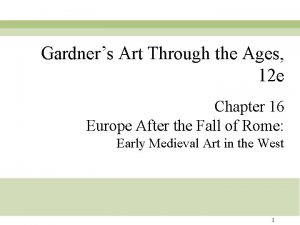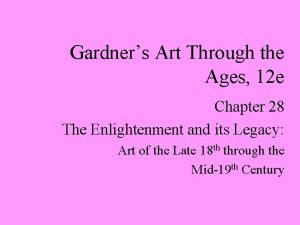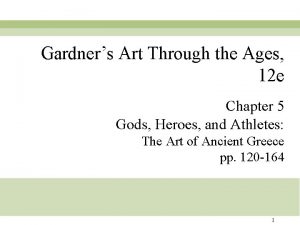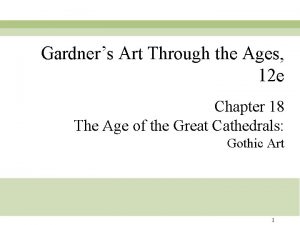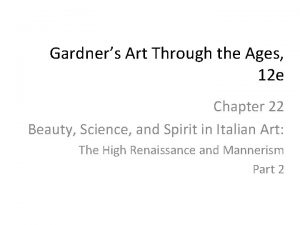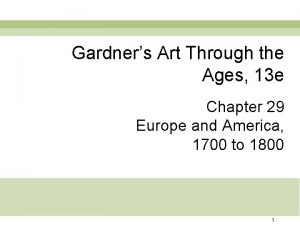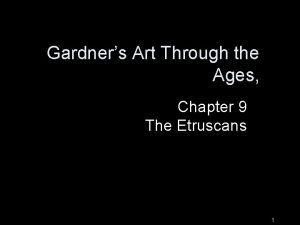Gardners Art Through the Ages 12 e Chapter



















- Slides: 19

Gardner’s Art Through the Ages, 12 e Chapter 33 The Development of Modernist Art: The Early 20 th Century Part 2

Colonial Empires About 1900

Futurism and other Responses to Cubism • Futurism was largely an Italian phenomenon, though there were parallel movements in Russia, England elsewhere. • The Italian writer Filippo Marinetti was its founder and most influential personality. He launched the movement in his Futurist Manifesto Futurist, which he published in 1909. In it Marinetti expressed a passionate loathing of everything old, especially political and artistic tradition. "We want no part of it, the past", he wrote, "we the young and strong Futurists!" The Futurists admired speed, technology, youth, and violence, the car, the airplane and the industrial city, all that represented the technological triumph of humanity over nature, and they were passionate nationalists.

FERNAND LÉGER, The City, 1919. Oil on canvas,

GIACOMO BALLA, Dynamism of a Dog on a Leash, 1912

UMBERTO BOCCIONI, Unique Forms of Continuity in Space, 1913 (cast 1931).

Figure 33 -21 GINO SEVERINI, Armored Train, 1915. Oil on canvas, 3’ 10” x 2’ 10 1/8”. Collection of Richard S. Zeisler, New York.

Dada: A State of Mind • Dada was an informal international movement, with participants in Europe and North America. The beginnings of Dada correspond to the outbreak of World War I. For many participants, the movement was a protest against the bourgeois nationalist and colonialist interests which many Dadaists believed were the root cause of the war, & against the cultural and intellectual conformity — in art &more broadly in society — that corresponded to the war [ • Many Dadaists believed that the 'reason' and 'logic' of bourgeois capitalist society had led people into war. They expressed their rejection of that ideology in artistic expression that appeared to reject logic and embrace chaos and irrationality. For example, George Grosz, later recalled that his Dadaist art was intended as a protest "against this world of mutual destruction". • According to its proponents, Dada was not art, it was “anti-art”. For everything that art stood for, Dada was to represent the opposite. Where art was concerned with traditional aesthetics, Dada ignored aesthetics. If art was to appeal to sensibilities, Dada was intended to offend. Through their rejection of traditional culture and aesthetics the Dadaists hoped to destroy traditional 8 culture and aesthetics.

Dada: A State of Mind Pt. 2 • According to its proponents, Dada was not art, it was “anti-art. ” For everything that art stood for, Dada was to represent the opposite. Where art was concerned with traditional aesthetics, Dada ignored aesthetics. If art was to appeal to sensibilities, Dada was intended to offend. Through their rejection of traditional culture and aesthetics the Dadaists hoped to destroy traditional culture and aesthetics. • Collage • The dadaists imitated the techniques developed during the cubist movement through the pasting of cut pieces of paper items, but extended their art to encompass items such as transportation tickets, maps, plastic wrappers, etc. to portray aspects of life, rather than representing objects viewed as still life. 9

Collage • The dadaists imitated the techniques developed during the cubist movement through the pasting of cut pieces of paper items, but extended their art to encompass items such as transportation tickets, maps, plastic wrappers, etc. to portray aspects of life, rather than representing objects viewed as still life. 10

JEAN ARP, Collage Arranged According to the Laws of Chance, 1916– 1917. Torn and pasted paper, 1’ 7 1/8” x 1’ 1 5/8”. Museum of Modern Art, New York (purchase).

KURT SCHWITTERS, Merz 19, 1920. Paper collage, approx. 7 1/4” x 5 7/8”. Yale University Art Gallery, New Haven, (gift of Collection Société Anonyme).

Readymades Marcel Duchamp began to view the manufactured objects of his collection as objects of art, which he called “readymades. ” He would add signatures and titles to some, converting them into artwork that he called "readymade aided" or "rectified readymades". One such example of Duchamp's readymade works is the urinal that was turned onto its back, signed "R. Mutt", titled "Fountain", and submitted to the Society of Independent Artists exhibition that year. [

MARCEL DUCHAMP, Fountain, 2 nd ver. 1950 (original version produced 1917). Ready -made glazed sanitary china with black paint, 12” high.

Assemblage The assemblages were three-dimensional variations of the collage - the assembly of everyday objects to produce meaningful or meaningless (relative to the war) pieces of work.

MARCEL DUCHAMP, The Bride Stripped Bare by Her Bachelors, Even (The Large Glass), 1915 -23. Oil, lead, wire, foil, dust, and varnish on glass, 9’ 1 1/2” x 5’ 9 1/8”. Philadelphia Museum of Art, Philadelphia (Katherine S. Dreier Bequest).

Photomontage The Berlin Dadaists - the "monteurs" (mechanics) would use scissors and glue rather than paintbrushes and paints to express their views of modern life through images presented by the media. A variation on the collage technique, photomontage utilized actual or reproductions of real photographs printed in the press.

HANNAH HÖCH, Cut with the Kitchen Knife Dada through the Last Weimar Beer Belly Cultural Epoch of Germany, 1919– 1920. Photomontage, 3’ 9” x 2’ 11 1/2”. Neue Nationalgalerie, Staatliche Museen,

George Grosz, "Eclipse of Sun" (1926); oil on canvas, approx. 82. 5" x 72. 5" "The cult of individuality and personality, which promotes painters and poets only to promote itself, is really a business. The greater the 'genius' of the personage, the greater the profit. " ~George Grosz (1893 -1959)
 Howard gardners theory of multiple intelligences
Howard gardners theory of multiple intelligences Multiple intelligences test
Multiple intelligences test Dark ages vs middle ages
Dark ages vs middle ages Renaissance vs medieval art
Renaissance vs medieval art Chapter 7 early childhood ages 3 through 5 answer key
Chapter 7 early childhood ages 3 through 5 answer key Literary archetypes
Literary archetypes Technology through the ages
Technology through the ages Art emerging in europe
Art emerging in europe Middle ages art characteristics
Middle ages art characteristics Chapter 12 lesson 4 the late middle ages
Chapter 12 lesson 4 the late middle ages Eleanor of aquitine
Eleanor of aquitine Through one man sin entered
Through one man sin entered Furcation involvement
Furcation involvement Disadvantages of tangential sawing
Disadvantages of tangential sawing Night of scorpion poem
Night of scorpion poem Hát kết hợp bộ gõ cơ thể
Hát kết hợp bộ gõ cơ thể Slidetodoc
Slidetodoc Bổ thể
Bổ thể Tỉ lệ cơ thể trẻ em
Tỉ lệ cơ thể trẻ em Voi kéo gỗ như thế nào
Voi kéo gỗ như thế nào




















